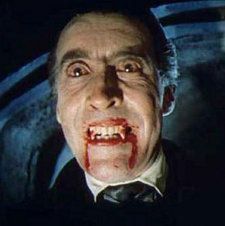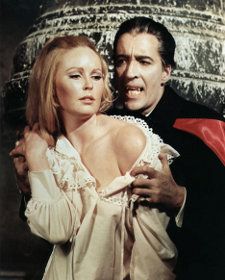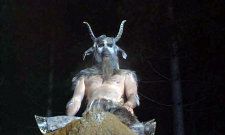
Christopher Lee is the quintessential Dracula
What does Dracula look like? He's been portrayed numerous times in numerous different ways, but if you're over 30 - and perhaps even if you're not - the chances are that the face you'll think of first is Christopher Lee's. Although he has appeared in more than 100 films, this is the role for which the actor is most fondly remembered, and his Dracula is perhaps Britain's most iconic anti-hero. Appearing in seven out of a series of nine films, he left an indelible mark not only on the throats of his victims but also on the British film industry. Filming his battles against Peter Cushing's stalwart Dr Van Helsing, Hammer hit a vein of financial and popular success that ensured their immortality.
It wasn't always so. The iconic studio first opened its doors in 1937, making mysteries and historical dramas, though they did feature Bela Lugosi in the decidedly eerie The Mystery Of The Marie Celeste. After a brief collapse into bankruptcy triggered by the global economic slump, they returned to concentrate on crime. The discovery that it was cheaper to shoot in the expansive interiors of English country houses than in studios led to the development of the trademark Hammer look, but it wasn't until 1955 that they moved into horror with an adaptation of hit TV series The Quatermass Experiment. The story of a strange capsule discovered on a run-down inner London estate, this mingles the alien and uncanny with strong psychological horror themes that remain powerful today. It thrilled the public and drew unexpectedly huge audiences. A sequel followed, and a fan following was born.
Looking around for further horror subject matter, Hammer became interested in the old Universal horror films, enormously popular with US audiences but at that time little-seen in Britain. As special effects technology had improved significantly since these films were made, and as Hammer were now able to shoot in colour, their core ideas and themes seemed worthy of revisiting. First up was The Curse Of Frankenstein, which teamed up Cushing (as the scientist) and Lee (as the monster) for the first time.

Although Lee couldn't quite outshine Boris Karloff, the film wowed audiences. They had never before seen bright red blood onscreen, and the predictable nervousness of the censors helped to garner further publicity. Still more excitement was generated by the presence of the glamorous Hazel Court, who introduced a new sexuality to horror, in contrast with the innocent imperilled beauties of the past. A major success in Italy as well as in its country of origin, the film has been credited as one of the inspirations of the Giallo subgenre.
The Curse Of Frankenstein would go on to spawn six sequels. "In those days Hammer were turning out eight films a year," said filmmaker Jonathan Sothcott, author of The Cult Films Of Christopher Lee, who has cited the studio as an inspiration. This was in an era when Saturday matinee serials were still running in some cinemas, so sequels, if anything, seemed more natural than they do today. Fans would wait eagerly for fresh instalments. Alongside the Frankenstein and Dracula franchises, Hammer developed a series of mummy films, combining the exotic glamour of ancient Egypt with the dark Gothic atmosphere of England's crumbling stately homes.
There were also several one-off creature features - The Gorgon, The Reptile and The Curse Of The Werewolf - plus several vampire films outside the Dracula canon. The most famous of these, The Vampire Lovers and Countess Dracula, established Ingrid Pitt as Hammer's greatest female star. Although she did play the occasional damsel in distress, Pitt was most notable for her voluptuous villainesses, and was easily charismatic enough to carry a film in her own right.
Having survived a concentration camp in her youth and, legend has it, swum across the Danube to escape from the communist regimes of Eastern Europe, she clearly relished her horror roles, which provided much more substantial material than was available to most actresses in the serious dramas of the period. Despite its frequently historic settings, Hammer was at the forefront of social change, not only providing meaty roles for women but using its vampire mythology as a softcore outlet for lesbian erotica, challenging longstanding cinematic taboos.

Of course, the permissive society, as it was then known, was not without its critics, and it was really that cultural tension that gave Hammer's racy subjects so much extra oomph. Dennis Wheatley, an establishment insider and strong critic of social change, wrote two of the novels whose adaptations gave Hammer its finest moments. To The Devil A Daughter and The Devil Rides Out both explore Satanism, a subject about which Wheatley expressed deep personal concern, perhaps contributing to their strong internal conviction. Both feature compelling performances from Lee, with strong support from other well known actors. They suggest a flirtation with a serious horror trying to escape the slightly camp reputation of the vampire films, and were accordingly more tightly produced. An interesting comparison piece is The Witches, by Quatermass author Nigel Kneale, in which a schoolteacher comes to suspect that one of her students is being prepared for sacrifice.
There are other, more esoteric entries in the Hammer canon, such as One Million Years BC (which made an overnight sensation out of Racquel Welch in her fur bikini) and Rasputin, in which Lee gives one of the most compelling performances to date as the unhinged monk who dominated the queen of Russia. It also turned out some notably dark psychological thrillers, such as The Nanny (with a great role for the ageing Bette Davis) and the underrated Straight On Till Morning.
In the Eighties, two television series seemed to mark a new direction, but reviews were never as strong as for the studio's films, and it was not until this year that the studio was ready to relaunch its film work. Let Me In, its adaptation of hit Swedish book/film Let The Right One In, has had mixed reviews but looks set to make a good return at the box office. With a slate of other productions lined up at Hammer, let's hope so. The house of horror may yet rise again.





















